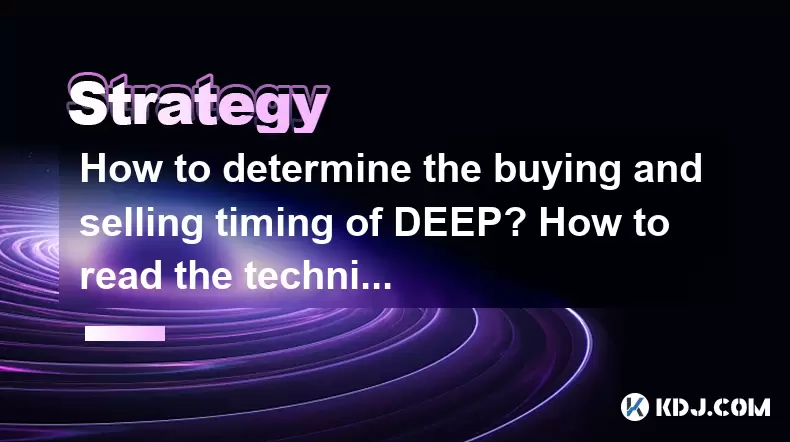-
 bitcoin
bitcoin $121833.232455 USD
-0.63% -
 ethereum
ethereum $4394.437030 USD
-2.00% -
 tether
tether $1.000570 USD
0.04% -
 bnb
bnb $1255.553465 USD
-3.73% -
 xrp
xrp $2.814944 USD
-1.59% -
 solana
solana $221.835346 USD
-2.40% -
 usd-coin
usd-coin $0.999869 USD
0.01% -
 dogecoin
dogecoin $0.249495 USD
-1.32% -
 tron
tron $0.336905 USD
-1.24% -
 cardano
cardano $0.816464 USD
-1.69% -
 chainlink
chainlink $22.130946 USD
-1.27% -
 hyperliquid
hyperliquid $44.208522 USD
-3.46% -
 ethena-usde
ethena-usde $1.000521 USD
0.02% -
 sui
sui $3.422897 USD
-2.51% -
 stellar
stellar $0.380164 USD
-1.31%
How to determine the buying and selling timing of DEEP? How to read the technical indicators?
Use MA crossovers, RSI, Bollinger Bands, and MACD to time DEEP buys and sells. Combine indicators for robust signals and align with market trends for best results.
May 21, 2025 at 08:01 am

Understanding the optimal timing for buying and selling cryptocurrencies like DEEP can significantly enhance your trading success. This guide will delve into how to read technical indicators and use them to make informed decisions about when to buy and sell DEEP. Let's explore the key aspects of this process.
Understanding DEEP and Its Market Dynamics
DEEP is a cryptocurrency that operates within a unique niche in the crypto market. To effectively trade DEEP, it's crucial to understand its market dynamics, including its volatility, trading volume, and the overall sentiment around it. Volatility can be a double-edged sword; it presents opportunities for high returns but also carries higher risks. Trading volume indicates the liquidity of DEEP, which can affect the ease of executing trades. Sentiment analysis involves gauging the general mood of the market towards DEEP, which can be influenced by news, social media, and other factors.
Key Technical Indicators for DEEP Trading
Technical indicators are tools used by traders to predict future price movements based on historical data. Here are some of the most important indicators for trading DEEP:
Moving Averages (MA): These help smooth out price data to identify trends. The Simple Moving Average (SMA) and Exponential Moving Average (EMA) are commonly used. A crossover of a short-term MA above a long-term MA can signal a buying opportunity, while the opposite can indicate a selling point.
Relative Strength Index (RSI): This momentum oscillator measures the speed and change of price movements. An RSI above 70 suggests that DEEP might be overbought, indicating a potential sell signal, while an RSI below 30 suggests it might be oversold, signaling a buy.
Bollinger Bands: These consist of a middle band being an SMA, with an upper and lower band calculated based on standard deviations. A price touching the upper band might indicate DEEP is overbought, while touching the lower band might suggest it's oversold.
MACD (Moving Average Convergence/Divergence): This trend-following momentum indicator shows the relationship between two moving averages of DEEP's price. A bullish crossover (when the MACD line crosses above the signal line) can be a buy signal, and a bearish crossover (when the MACD line crosses below the signal line) can be a sell signal.
Setting Up Your Trading Platform for DEEP
To effectively use technical indicators for trading DEEP, you'll need to set up your trading platform correctly. Here's how you can do it:
Choose a Reliable Trading Platform: Select a platform that supports DEEP trading and has robust charting tools. Popular options include Binance, Coinbase Pro, and Kraken.
Add DEEP to Your Watchlist: This will make it easier to monitor DEEP's price movements and apply technical indicators.
- Apply Technical Indicators:
- Moving Averages: Go to the chart settings, select 'Indicators,' and add the SMA or EMA. Set the periods according to your trading strategy (e.g., 50-day and 200-day for long-term trends).
- RSI: Add the RSI indicator to your chart. Set the period to 14, which is standard.
- Bollinger Bands: Add Bollinger Bands to your chart. Set the period to 20 and the standard deviation to 2.
- MACD: Add the MACD indicator. Set the fast period to 12, the slow period to 26, and the signal period to 9.
Analyzing DEEP's Price Movements
Once your platform is set up, you can start analyzing DEEP's price movements. Here's how to interpret the indicators:
Moving Averages: Look for crossovers. If the short-term MA (e.g., 50-day) crosses above the long-term MA (e.g., 200-day), it might be a good time to buy DEEP. Conversely, if the short-term MA crosses below the long-term MA, it might be a good time to sell.
RSI: Monitor the RSI values. If the RSI is above 70, DEEP might be overbought, suggesting a potential sell. If it's below 30, DEEP might be oversold, indicating a potential buy.
Bollinger Bands: Watch the price relative to the bands. If the price touches or exceeds the upper band, it might be overbought, suggesting a sell. If it touches or falls below the lower band, it might be oversold, indicating a buy.
MACD: Look for crossovers between the MACD line and the signal line. A bullish crossover suggests buying DEEP, while a bearish crossover suggests selling.
Combining Indicators for Better Decision-Making
Using a single indicator can be risky due to false signals. Combining multiple indicators can provide a more robust trading strategy. Here's how to do it:
Confirm Signals: Use multiple indicators to confirm a signal. For instance, if the MACD shows a bullish crossover and the RSI is below 30, it strengthens the buy signal.
Identify Trends: Use moving averages to identify the overall trend. If the trend is bullish, focus on buy signals from other indicators. If the trend is bearish, focus on sell signals.
Watch for Divergences: Look for divergences between price and indicators. For example, if DEEP's price is making new highs but the RSI is not, it might indicate a potential reversal, suggesting a sell.
Practical Example of Trading DEEP
Let's walk through a hypothetical scenario of trading DEEP using technical indicators:
- Scenario: You're monitoring DEEP's price and notice that the 50-day SMA has crossed above the 200-day SMA, indicating a bullish trend.
- Step 1: Check the RSI. It's at 28, suggesting DEEP might be oversold.
- Step 2: Look at the MACD. There's a bullish crossover, reinforcing the buy signal.
- Step 3: Check the Bollinger Bands. DEEP's price is near the lower band, further supporting the buy signal.
- Action: Based on the combined signals, you decide to buy DEEP.
Later, you notice:
- Scenario: The 50-day SMA crosses below the 200-day SMA, indicating a bearish trend.
- Step 1: The RSI is now at 72, suggesting DEEP might be overbought.
- Step 2: The MACD shows a bearish crossover.
- Step 3: DEEP's price is touching the upper Bollinger Band.
- Action: Based on these combined signals, you decide to sell DEEP.
Frequently Asked Questions
Q: Can technical indicators alone guarantee successful trading of DEEP?A: No, technical indicators are tools that help predict price movements based on historical data. They should be used in conjunction with other forms of analysis, such as fundamental analysis and market sentiment, to make well-rounded trading decisions.
Q: How often should I check the technical indicators for DEEP?A: The frequency depends on your trading strategy. For day traders, checking indicators multiple times a day might be necessary. For long-term investors, weekly or even monthly checks might suffice. It's important to align the frequency with your trading goals and risk tolerance.
Q: Are there any specific times of the day that are better for trading DEEP?A: Trading volumes and volatility can vary throughout the day. Typically, higher volumes are seen during the overlap of major market hours (e.g., when both the U.S. and Asian markets are open). However, the best time to trade DEEP depends on your strategy and the specific market conditions at the time.
Q: What should I do if the technical indicators give conflicting signals?A: Conflicting signals are common and can be challenging. In such cases, consider the strength of each signal, the overall market trend, and other factors like news events or significant announcements related to DEEP. It might also be wise to wait for a clearer signal or to reduce your position size to manage risk.
Disclaimer:info@kdj.com
The information provided is not trading advice. kdj.com does not assume any responsibility for any investments made based on the information provided in this article. Cryptocurrencies are highly volatile and it is highly recommended that you invest with caution after thorough research!
If you believe that the content used on this website infringes your copyright, please contact us immediately (info@kdj.com) and we will delete it promptly.
- Meme Coins, ETFs, and Crypto Regulations: Navigating the Wild West of Digital Finance
- 2025-10-10 10:25:15
- HYPE, PENGU, and BlockDAG: Decoding Crypto's Latest Moves
- 2025-10-10 10:25:15
- Robinhood, Zora, and the Web3 Creator Revolution: A New York Minute on Tokenized Futures
- 2025-10-10 10:30:01
- Trump, Super Bowl, and Halftime: A Wild 2025 Ride
- 2025-10-10 10:30:01
- Cardano, XRP, and DeFi Integration: A Bombshell Development?
- 2025-10-10 08:25:17
- VeChain's Market Cap Dip: Can VET Stage a Recovery?
- 2025-10-10 10:30:01
Related knowledge

Practical parameter settings for a Bitcoin multi-timeframe moving average system
Sep 18,2025 at 10:54pm
Optimizing Timeframe Combinations for Bitcoin Trading1. Selecting appropriate timeframes is crucial when building a multi-timeframe moving average sys...

How can I filter out false breakouts in Dogecoin high-frequency trading?
Sep 22,2025 at 01:00am
Understanding False Breakouts in Dogecoin Trading1. A false breakout occurs when Dogecoin's price appears to move beyond a defined support or resistan...

Techniques for identifying tops and bottoms in the Bitcoin on-chain NVT model
Sep 20,2025 at 07:54pm
Understanding the NVT Model in Bitcoin Analysis1. The Network Value to Transactions (NVT) ratio is often described as the 'P/E ratio' of the cryptocur...

What does the surge in open interest in Bitcoincoin futures mean?
Sep 20,2025 at 11:18pm
Understanding the Surge in Dogecoin Futures Open Interest1. A surge in open interest within Dogecoin futures indicates a growing number of active cont...

How can I use the Ethereum USDT premium to gauge market sentiment?
Sep 18,2025 at 11:55pm
Understanding the Ethereum USDT Premium1. The Ethereum USDT premium refers to the price difference between USDT (Tether) traded on Ethereum-based plat...

What should I do if Ethereum staking yields decline?
Sep 20,2025 at 06:18am
Understanding the Causes Behind Declining Ethereum Staking Yields1. The Ethereum network transitioned to a proof-of-stake consensus mechanism with the...

Practical parameter settings for a Bitcoin multi-timeframe moving average system
Sep 18,2025 at 10:54pm
Optimizing Timeframe Combinations for Bitcoin Trading1. Selecting appropriate timeframes is crucial when building a multi-timeframe moving average sys...

How can I filter out false breakouts in Dogecoin high-frequency trading?
Sep 22,2025 at 01:00am
Understanding False Breakouts in Dogecoin Trading1. A false breakout occurs when Dogecoin's price appears to move beyond a defined support or resistan...

Techniques for identifying tops and bottoms in the Bitcoin on-chain NVT model
Sep 20,2025 at 07:54pm
Understanding the NVT Model in Bitcoin Analysis1. The Network Value to Transactions (NVT) ratio is often described as the 'P/E ratio' of the cryptocur...

What does the surge in open interest in Bitcoincoin futures mean?
Sep 20,2025 at 11:18pm
Understanding the Surge in Dogecoin Futures Open Interest1. A surge in open interest within Dogecoin futures indicates a growing number of active cont...

How can I use the Ethereum USDT premium to gauge market sentiment?
Sep 18,2025 at 11:55pm
Understanding the Ethereum USDT Premium1. The Ethereum USDT premium refers to the price difference between USDT (Tether) traded on Ethereum-based plat...

What should I do if Ethereum staking yields decline?
Sep 20,2025 at 06:18am
Understanding the Causes Behind Declining Ethereum Staking Yields1. The Ethereum network transitioned to a proof-of-stake consensus mechanism with the...
See all articles

























![Web3 Crypto Market Morning Report: Fomo on the Bnb chain continues, Binance launches the chain-sweeping platform Meme Rush, the market value of Xiuxian exceeds 40 million U.S. dollars, OK Binance business war begins [Vic TALK Issue 1437] Web3 Crypto Market Morning Report: Fomo on the Bnb chain continues, Binance launches the chain-sweeping platform Meme Rush, the market value of Xiuxian exceeds 40 million U.S. dollars, OK Binance business war begins [Vic TALK Issue 1437]](/uploads/2025/10/10/cryptocurrencies-news/videos/web-crypto-market-morning-report-fomo-bnb-chain-continues-binance-launches-chainsweeping-platform-meme-rush-market-xiuxian-exceeds-dollars-binance-business-war-vic-talk-issue/68e861c5dbd1c_image_500_375.webp)
















































